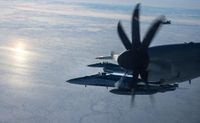The U.S. Director of National Intelligence (DNI) Annual Threat Assessment report, published on March 25, 2025, paints a sobering picture of the strategic threats facing the United States. Despite a change in government, these threats are intensifying, particularly with China enhancing its capabilities across the five domains of warfare. This shift is improving China's ability to gain coercive leverage against Washington in emerging areas of strategic competition.
One of the most alarming developments is the deepening military cooperation between Beijing and Moscow, which is undermining the United States' ability to secure its vital interests. As the report indicates, Washington must enhance deterrence across these emerging areas of competition to counter the joint threat posed by China and Russia.
The Federation of American Scientists recently published estimates indicating that China now possesses approximately 600 nuclear warheads, a significant increase from just 175 in 2010. The Pentagon has warned that by 2035, China is projected to become a nuclear peer of the United States, with an anticipated deployment of 1,500 nuclear warheads across its land, air, and sea-based triad. Together, China and Russia now possess a combined nuclear force of roughly 6,200 warheads, nearly double the total force size of the United States' deployed nuclear forces, which stands at 3,700 warheads.
This current nuclear balance heavily disfavors the United States, raising concerns about its vulnerability to a nuclear first strike, which could inflict catastrophic casualties. The report warns that both China and Russia have sufficient nuclear forces to credibly target over 150 of the United States' largest cities. A nuclear first strike against the United States could result in an estimated 130 million American casualties. In 2024 alone, China possessed the long-range nuclear ballistic missile capability to hold approximately 72,697,923 American civilians at risk.
In addition to nuclear threats, the report highlights that China has surpassed Russia as Washington's main competitor in space. As stated in the DNI report, "China has eclipsed Russia as a space leader and is poised to compete with the United States as the world’s leader in space by deploying increasingly capable interconnected multi-sensor systems and working toward ambitious scientific and strategic goals." This shift in space capabilities poses new challenges for U.S. military operations and civilian infrastructure.
China's counterspace capabilities are continually evolving, encompassing a range of kinetic assets that can target and strike the United States in orbit, on land, in the air, and at sea. For instance, operational space-based direct ascent capabilities are paired with ground-based space capabilities that can be employed for both offensive and defensive purposes. Anti-satellite (ASAT) missiles, which can destroy low-Earth orbit (LEO) satellites, are capable of striking targets at distances ranging from 800 to 30,000 kilometers above Earth.
In recent years, the People's Republic of China conducted its first fractional orbital launch of an Intercontinental Ballistic Missile with a hypersonic glide vehicle, demonstrating the greatest distance flown (approximately 40,000 kilometers) and longest flight time (over 100 minutes) of any Chinese land attack weapons system to date. Scholars Caitlin Talmadge and Joshua Rovner noted that while the hypersonic glide vehicle tested was nuclear-capable, there was no indication that a nuclear weapon was mounted atop the fractional orbital bombardment system (FOBS) used.
Closer to U.S. soil, the military cooperation between China and Russia is evident in their joint air and naval patrols along the Alaskan coast. In July 2024, two Chinese H-6 nuclear-capable bombers operating in the Alaska Air Defense Identification Zone were intercepted by U.S. and Canadian airmen. This operation marked the first time that China and Russia conducted a joint patrol near Alaska, further demonstrating their ability to target and threaten American vital interests.
Senator Dan Sullivan of Alaska, who serves on the Senate Armed Services Committee, stated, "As the world becomes more dangerous, Alaska continues to be on the frontlines of authoritarian aggression. Coordinated activity off Alaska’s shores by the Russians and Chinese is increasing." This statement underscores the growing concerns regarding the threats posed by these adversaries.
The DNI report emphasizes that the cooperation between China and Russia poses enduring risks to U.S. interests, as their leaders likely believe they can counter perceived U.S. aggression more effectively together than alone. In light of this assessment, Washington must confront the reality that failure to enhance deterrence could incentivize Beijing and Moscow to undertake greater geopolitical risks at the expense of the United States.
War in space, as the report warns, would have catastrophic consequences. Moreover, failure to confront adversarial threats in the United States' backyard could embolden China and Russia to intensify their challenges to U.S. vital interests. As the strategic landscape continues to evolve, the U.S. must reassess its approach to deterrence and defense to safeguard its national security and global standing.



